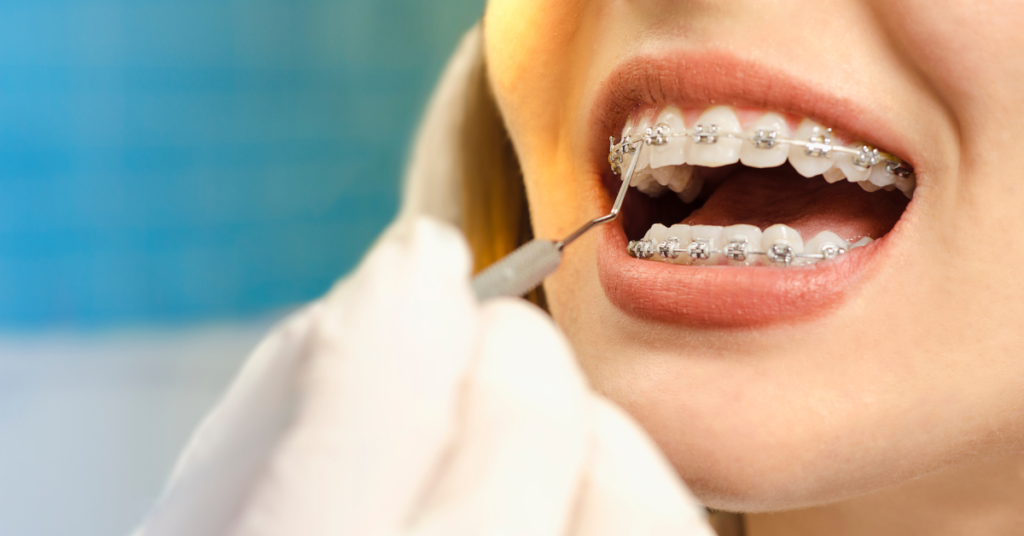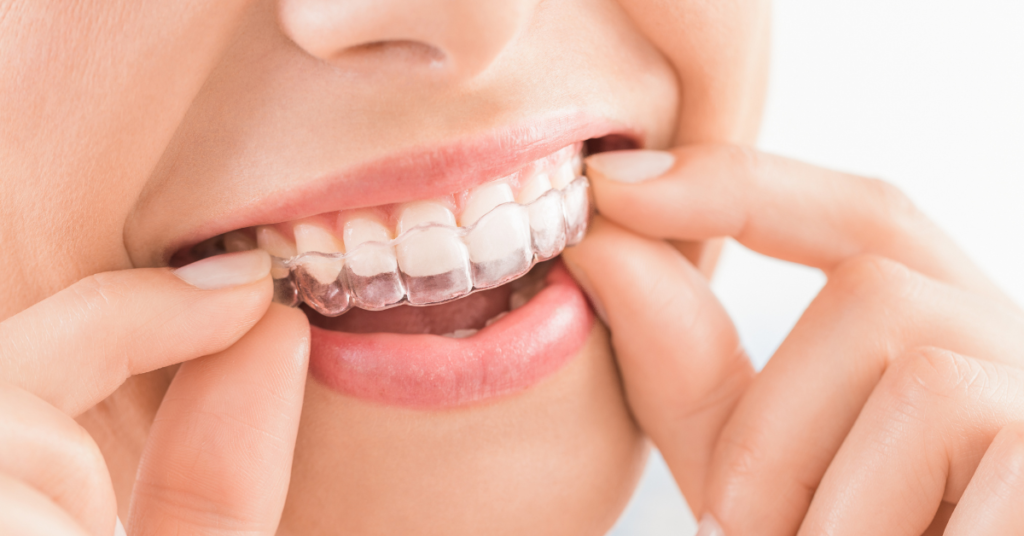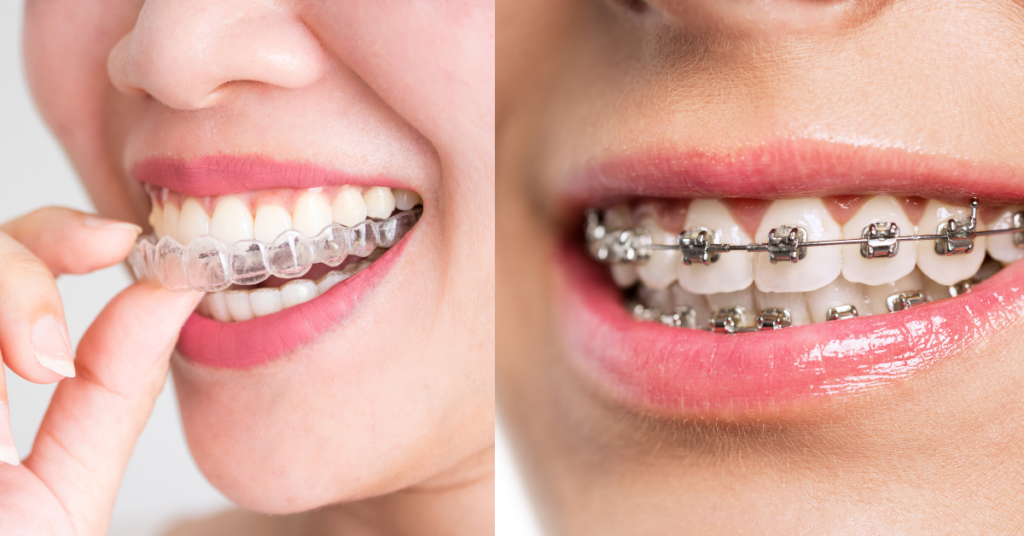
Introduction
Braces and Invisalign are popular orthodontic treatments designed to straighten teeth and improve your bite. Braces are the traditional method, consisting of metal brackets and wires that apply gentle pressure to reposition teeth over time. On the other hand, Invisalign uses a series of clear, removable aligners that gradually shift your teeth into their desired position.
Achieving straight teeth and a proper bite is essential for more than just an attractive smile. Misaligned teeth can lead to various dental problems, including jaw pain, difficulty chewing, speech issues, and an increased risk of tooth decay and gum disease. Straightening your teeth can improve your oral health, boost your confidence, and even prevent future dental issues.
One of the patients’ most common questions when considering orthodontic treatment is whether Invisalign works faster than braces. While the duration can vary depending on individual cases, Invisalign typically requires a shorter treatment time compared to traditional braces. However, the effectiveness and suitability of each option may depend on the complexity of the dental issues being addressed.
Understanding Braces

How Braces Work
Braces are a time-tested orthodontic treatment that applies continuous pressure to gradually shift teeth into their desired positions. The brackets are bonded to the front surfaces of your teeth, and an archwire connects them, exerting gentle force. During regular appointments, your orthodontist will adjust the wire, slowly moving your teeth into proper alignment.
Types of Braces
While metal braces are the most common type, there are several other options available:
- Metal Braces: The traditional choice, made of high-grade stainless steel and offering excellent durability and affordability.
- Ceramic Braces: These tooth-colored braces blend in with your natural tooth color, providing a more discreet appearance.
- Lingual Braces: Placed on the inside surfaces of your teeth, lingual braces are virtually invisible from the outside.
- Self-Ligating Braces: These braces use specialized clips instead of elastic ties, reducing friction and potentially shortening treatment time.
Ideal Age for Braces Treatment
While braces can be effective at any age, most orthodontists recommend starting treatment between the ages of 9 and 14. During this period, a child’s jawbone and teeth are still developing, making it easier to guide their growth and achieve optimal results. However, adults can also benefit from braces, although the treatment may take longer due to their fully developed jawbones.
Treatment Duration for Braces
The length of treatment with braces can vary significantly, depending on factors such as the severity of the dental issues, patient compliance, and the type of braces used. On average, traditional metal braces require 18 to 24 months of treatment, but some cases may take longer or be resolved more quickly.
Exploring Invisalign

What is Invisalign?
Invisalign is a modern, virtually invisible alternative to traditional braces. It uses a series of clear, removable aligners made from a smooth, BPA-free plastic material. These aligners are custom-made to gradually shift your teeth into their desired positions over time, without the need for metal brackets or wires.
How Invisalign Works
The Invisalign process begins with a comprehensive evaluation by your orthodontist, who will take digital impressions or scans of your teeth. These scans are used to create a 3D model of your mouth, allowing the Invisalign team to plan out your entire treatment process. You’ll receive a set of custom-made aligners, each designed to make slight adjustments to your teeth’s positioning.
Benefits of Invisalign
Invisalign offers several advantages over traditional braces, including:
- Discreet Appearance: The clear aligners are virtually invisible, allowing you to straighten your teeth without drawing unwanted attention to your orthodontic treatment.
- Removable for Eating and Cleaning: Unlike braces, which are fixed in place, you can remove your Invisalign aligners when eating, brushing, or flossing, making it easier to maintain good oral hygiene.
- Comfortable Fit: The smooth, plastic aligners are designed to fit snugly over your teeth without the discomfort or irritation sometimes caused by metal brackets and wires.
Treatment Duration for Invisalign
While treatment times can vary, Invisalign often requires a shorter duration compared to traditional braces. On average, most patients can achieve their desired results within 12 to 18 months, but some cases may be resolved in as little as 6 months or may take up to 24 months, depending on the complexity of the dental issues.
Comparing Braces and Invisalign

Appearance and Aesthetics
One of the most significant differences between braces and Invisalign lies in their appearance. Traditional braces are highly visible, with metal brackets and wires attached to the front of your teeth. This can be a concern for many adults and teenagers who may feel self-conscious about their appearance during treatment. Invisalign aligners, on the other hand, are virtually invisible, making them an ideal choice for those who want a discreet orthodontic solution.
Convenience and Lifestyle
Invisalign offers a level of convenience that is difficult to achieve with traditional braces. Since the aligners are removable, you can continue to enjoy your favorite foods without worrying about getting particles stuck in your braces. Additionally, maintaining good oral hygiene is easier with Invisalign, as you can remove the aligners for brushing and flossing.
Treatment Duration
While the treatment duration can vary based on individual cases, Invisalign generally requires a shorter treatment time compared to traditional braces. On average, Invisalign treatment takes 12 to 18 months, while braces typically require 18 to 24 months or longer. However, it’s important to note that the severity of the dental issues and patient compliance plays a significant role in determining the overall treatment duration.
Effectiveness for Different Dental Issues
Both braces and Invisalign are effective at correcting a wide range of dental issues, such as crowding, spacing, overbites, underbites, and crossbites. However, traditional braces may be better suited for addressing more complex cases, such as severe jaw misalignments or skeletal issues. Your orthodontist will evaluate your specific needs and recommend the most appropriate treatment option.
Cost Considerations
The cost of orthodontic treatment can vary depending on several factors, including the type of treatment, the complexity of the case, and the location. Generally, Invisalign tends to be more expensive than traditional braces, but the cost difference may be offset by the potential for shorter treatment duration and the added convenience and discreet appearance of the clear aligners.
Factors Affecting Treatment Duration
Severity of Dental Issue
The severity of the dental issues being addressed is one of the primary factors that determine the treatment duration for both braces and Invisalign. More complex cases, such as severe misalignments or jaw discrepancies, typically require longer treatment times compared to milder cases of crowding or spacing issues.
Patient Compliance and Consistency
Patient compliance plays a crucial role in the success and duration of orthodontic treatment. With braces, patients must follow their orthodontist’s instructions for proper care and avoid certain foods that could damage the brackets or wires. For Invisalign, patients must wear their aligners for at least 22 hours per day and change them as directed to ensure the treatment progresses as planned.
Age and Jaw Development
The age of the patient and the stage of their jaw development can also impact treatment duration. Generally, younger patients with developing jaws tend to respond more quickly to orthodontic treatment compared to older patients with fully developed jaws. This is because the jawbones are more malleable and easier to guide during the growth phase.
Type of Braces or Aligners Used
The specific type of braces or aligners used can also influence the treatment duration. For example, self-ligating braces, which use specialized clips instead of elastic ties, may reduce friction and potentially shorten treatment times. Similarly, Invisalign’s advanced aligner technology and treatment planning software may contribute to a more efficient and streamlined process.
Making the Right Choice

Assessing Your Needs and Preferences
When deciding between braces and Invisalign, it’s essential to carefully consider your individual needs, lifestyle, and preferences. Factors such as the severity of your dental issues, your age, and your desired level of discretion during treatment should all play a role in your decision-making process.
Consulting with an Orthodontist
Consulting with an experienced orthodontist is crucial in determining the most appropriate treatment option for your specific case. During your initial consultation, the orthodontist will thoroughly evaluate your dental condition, discuss your goals and concerns, and provide professional recommendations based on their expertise.
Weighing the Pros and Cons
Both braces and Invisalign have their own set of advantages and disadvantages. While braces offer a time-tested and effective solution, they can be more noticeable and may require dietary restrictions. Invisalign, on the other hand, provides a discreet and convenient option but may not be suitable for all types of dental issues. Weighing these pros and cons against your personal preferences can help you make an informed decision.
Considering Long-Term Dental Health
Ultimately, the choice between braces and Invisalign should be driven by your long-term dental health goals. Both treatments aim to correct dental misalignments, improve your bite, and enhance your overall oral health. By carefully considering your options and following your orthodontist’s recommendations, you can achieve a healthier, more beautiful smile that will last a lifetime.
Conclusion
Choosing between braces and Invisalign involves carefully weighing factors such as treatment duration, appearance, convenience, and effectiveness for your specific dental issues. While Invisalign often offers a shorter treatment time and a more discreet appearance, traditional braces may be better suited for addressing complex cases or severe misalignments.
It’s crucial to consult with an experienced orthodontist who can thoroughly evaluate your dental condition and provide professional guidance on the most appropriate treatment option. Their expertise and recommendations will play a vital role in ensuring successful results and a healthier, more beautiful smile.
Regardless of whether you choose braces or Invisalign, the journey toward a straighter, healthier smile requires patience, dedication, and a commitment to following your orthodontist’s instructions. By embracing the process and maintaining proper oral hygiene throughout your treatment, you’ll be able to achieve a stunning, confident smile that will last a lifetime.
